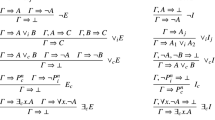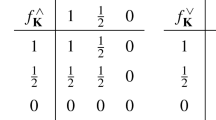Abstract
Minimal entailment is the semantical counterpart of Circumscription and Closed World Assumption. In this paper we show that it is possible to formalize minimal entailment at the propositional level, using standard deduction methods. Firstly we present a tableau procedure which is a natural reformulation of Smullyan's Analytic Tableaux. Then we introduce the sequent calculus MLK which is an extension of Gentzen's LK calculus. We prove that both are sound and complete formalizations of minimal entailment. Various extensions of the proposed methods are also discussed.
Similar content being viewed by others
References
Bossu, G. and Siegel, P., ‘Saturation, nonmonotonic reasoning and the closed world assumption’, Artificial Intelligence 25, 13–63 (1985).
Clark, K. L., ‘Negation as failure’ in: Logic and Databases (H. Gallaire and J. Minker, Eds.), Plenum Press, New York (1978), pp. 293–322.
Gabbay D., Theoretical foundations for non-monotonic reasoning in expert systems’ in: Logic and Models of Concurrent Systems (K. R. Apt, Ed.), Springer Verlag (1985), pp. 439–458.
Gelfond, M. and Lischitz, V., ‘Compiling circumscriptive theories into logic programs’, in: Non-Monotonic Reasoning: 2nd Workshop (M. Reinfrank, J. de Kleer, M. Ginsberg and E. Sandewell, Eds.), Springer Verlag (1989), pp. 74–99.
Gelfond, M., Przymusinska, H. and Przymusinski, T., ‘On the relationship between Circumscription and Negation as Failure’, Artificial Intelligence 38, 75–94 (1990).
Gentzen, G., ‘Untersuchungen uber dass logische Schliessen’, Mathematische Zeitschrift 39, 176–210. (1935).
Hintikka, J., ‘Model minimization — an alternative to circumscription’, Journal of Automated Reasoning 4, 1–13 (1988).
De Kleer, J. and Konolige, K., ‘Eliminating the fixed predicates from a circumscription’, Artificial Intelligence 39, 391–398 (1980).
Lifschitz, V., ‘Computing circumscription’ in: Proceedings of IJCAI, Los Angeles (1985), pp. 121–127.
Lifschitz, V., ‘Closed-world databases and circumscription’, Artificial Intelligence, 27, 229–235 (1985).
Lloyd, J. W., Foundations of Logic Programming, Springer Symbolic Computation Series, Berlin (1984).
McCarthy, J., ‘Circumscription — a form of nonmonotonic reasoning’, Artifical Intelligence 13, 295–323 (1980).
McCarthy, J., ‘Applications of circumscription to formalizing commonsense knowledge’, Artificial Intelligence 28, 89–118 (1986).
Minker, J., ‘On indefinite databases and the closed world assumption’ in: Proceedings of 6th Conference on Automated Deduction, LN in Computer Science, Vol. 138 (1982), pp. 292–303.
Olivetti, N., ‘Ricerche logiche sul ragionamento non-monotono’, Tesi di Laurea, Universita’ di Torino, a.a. 1987/1988.
Olivetti, N., ‘Circumscription and closed world assumption’, to appear in Atti dell' Accademia delle Scienze di Torino.
Perlis, D. and Minker, J., ‘Completeness results for circumscription’, Artificial Intelligence 28, 29–42 (1986).
Przymusinski, T., ‘An algorithm to compute circumscrition’, Artificial Intelligence 38, 49–73 (1990).
Reiter, R., ‘On closed world databases’, in: Logic and Databases (H. Gallaire and J. Minker, Eds.), Plenum Press, New York (1978), pp. 55–76.
Shepherdson, J. C., ‘Negation as Failure II’, Journal of Logic Programming 3, 185–202 (1985).
Shoham, Y., ‘Nonmonotonic logics: meaning and utility’ in: Proceedings of 10th IJCAI, Milan (1987), pp. 388–393.
Shoham, Y., ‘A semantical approach to nonmonotonic logics’ in: Proceedings of Logics in Computer Science, Ithaca, N.Y. (1987), pp. 227–250.
Smullyan, R. M., First Order Logic, Springer-Verlag, Berlin (1968).
Author information
Authors and Affiliations
Rights and permissions
About this article
Cite this article
Olivetti, N. Tableaux and sequent calculus for minimal entailment. J Autom Reasoning 9, 99–139 (1992). https://doi.org/10.1007/BF00247828
Received:
Accepted:
Issue Date:
DOI: https://doi.org/10.1007/BF00247828




